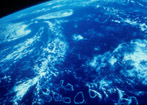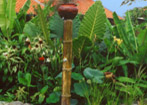| |
Phoenix Islands, Kiribati
22nd November 19th December 2004
The Phoenix
Islands are a widely spread group of eight islands located just south of
the Equator and almost a thousand miles from anywhere else on the planet.
Only two of the islands are inhabited the chief island Kanton and Orona
(Hull) where a settlement programme was started again in 2001.
There was a
great flurry of excitement in the biospheric world when National
Geographic published an article about these islands in early 2004,
heralding them as one of the last wildernesses of the worlds oceans. And
for a long time now, we have been very much looking forward to our time
there, to discover the state of health of these coral reefs that are so
geographically removed from direct human impacts.
On 22nd
November, we lowered the Zodiac in reasonably calm seas to launch three
exploratory dives into the waters surrounding Sydney Island (Manra in the
Kiribas language). The Heraclitus remained hove to a mile offshore. There
are few places for us to anchor here in the Phoenix Islands, which meant
that our seamanship skills and our ability to look after the ship close to
shore had to be very strong, in order to increase our potential of
exploration. As we were poised on the edge of the Zodiac, ready to launch
ourselves onto the reef below, we saw rapid movements of long silhouettes
beneath us sharks, many of them approaching the small boat rapidly
and with great interest. Michel grabbed a wooden stick and went in to
test the reception we might expect. Once we had the all clear, we
descended to enjoy the sight of so many sharks, including many frisky
juveniles, on one reef is this how all thriving reef communities should
look? Are there always supposed to be this many sharks? If so, then we
have stolen from the biosphere one of our most elegant animals. We
watched mostly grey reef sharks, also black tips and whitetips, snake
around us, approaching quite closely but never threatening.
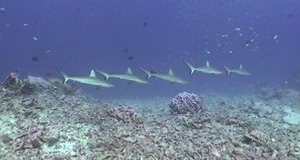
grey reef sharks on parade at Sydney Island
The fish
populations were flourishing red snappers, jacks, great barracuda,
clouds of anthias, plenty of parrotfish including the large steephead
parrotfish. But when we could peel our eyes away from the dancing fish to
see what lay behind them, the reef structure was in a devastated state with most hard coral colonies covered in a pink encrusting algae
that we have also seen in other parts of the South Pacific, especially Tokelau and Rarotonga.
This began our voyage through the paradox of the Phoenix Islands - at
Sydney, Enderbury, Kanton, McKean and Nikumaroro islands we were to find
stunning fish populations but up to 95% of the hard corals on these reefs
have died in the last two and a half years.
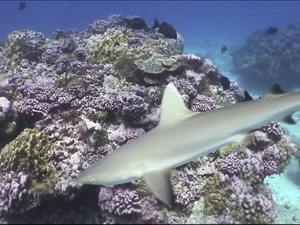
this young grey reef shark passes in front of mostly algae covered
corals
We searched
further through the reports of the New England Aquarium expeditions in
June/July 2000 and 2002 for their impressions of the state of the corals
to probe further into what they had seen. We made plans to stop at as
many islands as possible in the group to gather as wide a range of
impressions for ourselves as possible.
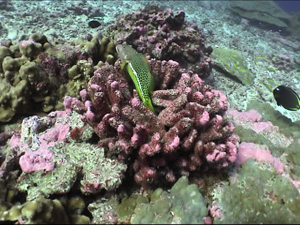
the hawkfish sits on his usual perch - a Pocillopora - but this coral
is dead
We had hoped
to make another dive expedition at Phoenix Island, but the weather was
against us. The swells were too high and the wind too strong to allow us
to heave to or dive safely so we took the wind and continued moving
northwards.
On 24th
November, the seas had calmed enough for us to stop at Enderbury Island.
There are no trees on the island it is a barren looking, guano-stinking
strip of white, speckled with the black, brown and grey bodies of frigate
birds, boobies, terns. It was mined for its phosphate for a while and
also served as a military base until the late 1970s. But there is nobody
there now, apart from a small sailing yacht anchored close to shore. Our
diving there continued on the theme of Sydney Island plenty fish,
including all the top predators, but a very damaged reef beneath them.
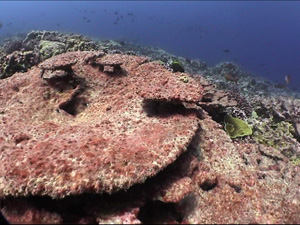
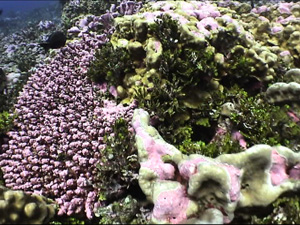
wide and closer views of the corals that used to be
We arrived at
Kanton on 26th November, a very friendly pod of bottlenose
dolphins gathering around us just before we dropped the anchor outside the
pass into the lagoon. This was the best position we could find, on the
leeward side of the island, holding on to the shelf of the mostly dead
reef. But we had to be ready to leave at any moment should the wind move
around to the west. Luckily the weather stayed on our side for nearly two
weeks, allowing us to carry out a full study on the fringing reef of the
atoll and the lagoon interior.
We explored
as fully as we could in the water and encountered incredible beauty in
the sea. The dolphins would spend the last few hours of each day with us
in the Zodiac, charging just ahead of the bow and encouraging us to ride
with them as we hung off the side. Manta rays gathered at the entrance to
the lagoon, feeding furiously on the incoming tide that can reach a
phenomenal speed of up to 10 knots. We rode these currents, flying along
the seafloor, one day swirling with twenty mantas. The sharks are here
too but not to the extent of the previous stops. The greater part of
the shark populations here were fished out quite heavily in a money-making
scheme by the government but they have not been decimated completely.

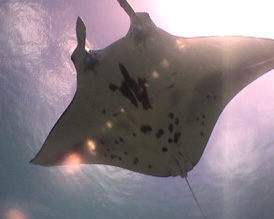
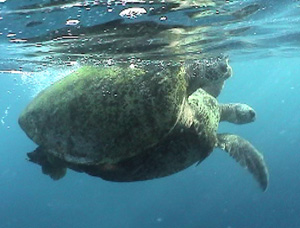
bottlenose dolphins, manta rays, mating turtles - the big animals have
not yet been impacted by the reef's devastation
We fished
like we have never fished before catching up to ten big-eye tuna each
evening before sunset while trolling from the small boat. And rainbow
runners that had taken a liking to the hull in Sydney Island remained with
us during our stay in Kanton (and on til our departure from Nikumaroro
Island a week later) allowing us to catch a fresh lunch most days.
But the story
of the reef didnt change. Very few patches of reef that we discovered
were alive or even remotely resembling the pristine reefs described from
the surveys of 2002. Inside the lagoon was heartbreaking the enormous
fields of table Acroporas that cover the floor just inside the
entrance were all completely dead. Fish still rove around these
skeletons, including sharks and turtles, but there is nothing left alive
as a substrate, bar the occasional clump of macroalgae.

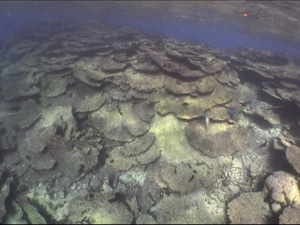
the table Acroporas - skeletons on the lagoon floor
What happened
in the last two and a half years to bring this about? The 2002 report
from the New England Aquarium expedition mentions a hot-spot beginning
during their stay elevated sea surface temperatures. They saw a few
corals beginning to react, bleaching white as they expelled the
microscopic algae inside their tissues. As the scientists left, most of
the corals were still intact, but NOAA reported this spell of raised ocean
temperature lasting for the three months that followed reaching the
critical threshold when few bleached corals can sustain themselves without
their zooxanthellae partners. So perhaps what we were now seeing was the
aftermath of a mass bleaching event, that soared through the Phoenix
Islands like a bush-fire. It seems the most likely cause of this sudden
death but even knowing the cause does not alleviate the sense of loss
that we all felt continuously diving on these reefs.
Our
relationship with the families living on Kanton began as soon as we
arrived. Seven couples have been posted from the Gilbert Islands, about a
thousand miles to the west, to act as caretakers for this previously much
sought after central Pacific landmass. It has been a strategic military
site during World War 2, a refueling stopover for transoceanic flights, a
satellite tracking station during the later twentieth century. The
remnants of these incarnations lie scattered around the island an
overgrown runway here, a satellite dish there, fuel tankards on the
crumbling dock, and the wreck of a US troop transport ship protruding
above the water line at the entrance into the tricky pass. The garbage
left behind by these technological incarnations is now the playground for
the children of Kanton but some sites are off limits because of dangerous
chemical waste.

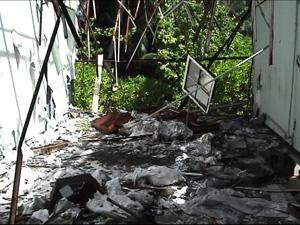
the satellite dish and the techno-wreckage of Kanton
We were
invited the day after our arrival to a welcome feast at the village. A
tractor towed a truck with a stoved-in roof and a platform at the back
where we could sit the Kanton limousine. We arrived at the traditional
style meeting house (an old cement floored structure with corrugated roof)
there were prayers, a formal introduction of each islander and their
role (the policeman, the radio operator, the diesel man, the carpenter
etc.). We feasted on huge lobsters, roasted pig, breadfruit, papaya,
rice, desserts. And they sang to us - the Kiribati culture holding
together these families that were strangers to each other before their
arrival at this faraway island. One of the men, Tamayano, became a great
friend of the ship. He is the fisherman he spends hours out in his
wooden boat, trolling for fresh fish to feed the community. We were told
stories of how he used to have a special relationship with sperm whales at
the island he would catch plenty tuna and then hand-feed the whales.
But when he left the island for a while, his son neglected to maintain the
relationship and so the whales have not come for a long time. He would tie
off to the Heraclitus at night and fish for hours, never failing to catch.
He taught Michel a Kiribati dance, the words, the song, the gesture and
the meaning behind them all.
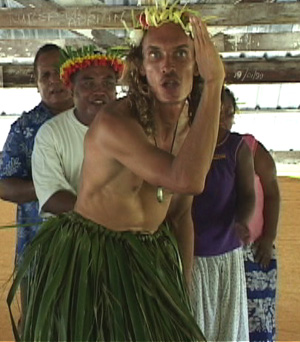
Michel dances with the support of the island's singers
We returned
the hospitality to this incredible village by inviting the children and
then the grownups to the Heraclitus, and there was always singing
involved! The children are currently in the hands of a great lady, Donna,
who is teaching them song, dance and guiding them in theatre. As we
prepared to leave, the children rushed to complete their Christmas
performance so that we could see it before we departed. Just days before
this intended farewell gathering, our anchor dragged off the reef and
despite many attempts to find a holding ground again, it was impossible.
So we drifted offshore for two days to maintain our appointment at the
feast. We watched the children receive their cash prizes for end of term
results. They led the way towards a table laden with food more
lobsters, more pig, more breadfruit and papaya delights, all washed down
with sweet young coconuts.
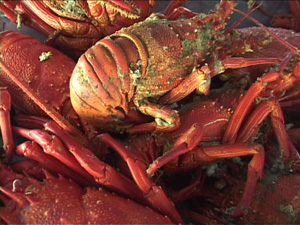
And then we
sat back to enjoy their performance a legend about the most beautiful
girl of the islands who is pursued by many men. But in their ocean
voyages to seek her, many are tricked by a witch who chops off the legs
and arms of the suitors. One young ugly man is eventually transformed by
a long journey in his sailing canoe and wins the heart of the beautiful
girl. All the costumes, the props and scenery for the play were made from
coconut tree palms, shells, fresh flowers, and gatherings from the atoll
ecosystem a stark contrast to the dilapidated concrete structures,
mangled metal and fatigued machinery that make up much of the backdrop of
the island.
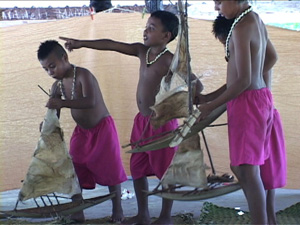
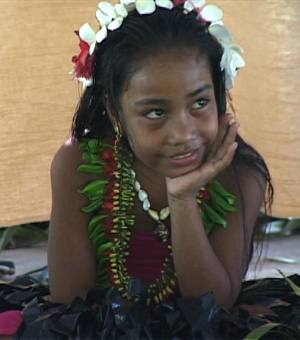
the sailor-suitors and their beautiful quest
We shared all
these cultural delights with two other yachts who are spending a few
months in the lagoon Daniel and Lucy with their two children, Noah and
Elia, plus Alan, a single-handed sailor/explorer from Chile. We exchanged
information and goods about weather, about future plans, about
navigation and about starting our own on-board yogurt production line!
And with our
anchor already raised two days ago, we merely drifted a little further
offshore and raised the sails to make our formal departure from Kanton.
In just two weeks we had thoroughly explored the outside reef, the lagoon,
made firm friends with the islanders, the manta rays and the dolphins.
Two of them came to ride the Heraclitus bow as a farewell.
We had two
more stops to make on our Phoenix expedition McKean Island and
Nikumaroro Atoll. The swells were fairly large when we arrived at McKean,
a skinny sandbar with a recently wrecked fishing ship driven right onto
the shallow reef shelf. The sharks here were over-excited to see us, the
corals were in a fraction better state than we had seen previously. The
waters were packed. We only stayed for a few hours, the island affording
us no protection from the swells.
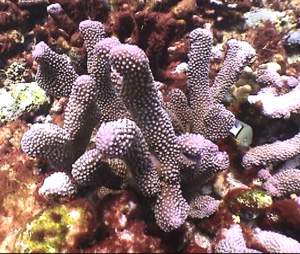

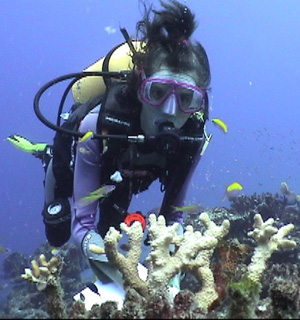
struggling and dead corals at McKean
We moved on
to arrive at Nikumaroro (Gardner) Atoll by the 16th December.
After all our practice at Kanton of drifting offshore, it was an easy
matter for us to stay three full days to explore as much as possible both
in the water and on the land. Teams went to the reef to gather
photographs, video footage and data.

a healthy school of blue jacks roam over a dead Pocillopora field
Teams went to
the island to gather drinking coconuts. Fishing was out of the question
the sharks pounced on the catch before it could be reeled in. There were
playful bottlenose dolphins here too and curious manta rays.

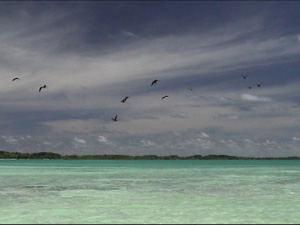
blacktip juveniles roam the shallows of the lagoon at Nikumaroro
On the
evening before we departed, Michel, Heather and Kitty watched an
incredible scene unfold before them. They were looking for the dolphins
but instead found a pod of false killer whales. Michel sought contact
with them in the water but a two metre marlin kept coming between them,
with each pass coming closer and closer to Michel. The razor-sharp bill
pointed straight at Michel, he made several emergency exits from the
water. After he had made his final leap into the Zodiac, the whales
gathered around the marlin and tore him to pieces. The three watched in
amazement, smelling the carnage and the blood from the small boat.
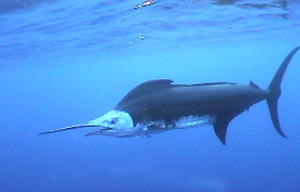
the marlin seconds before he met his fate
Could there
be a more appropriate finale to our time here in these islands? Despite
the reefs being almost utterly dead, the ocean here is exploding with
life. Are these memories that we now hold of underwater spectacles a
glimpse into the ocean life that Sylvia Earle remembers from her
childhood? Should the seas the world over be this alive? Is this how
they used to be? Sharks, dolphins, whales, rays, tuna, school upon school
of fish jumping through imaginary hoops across the boundary between sea
and sky, dancing between our world and theirs. The mobile life here has
been (almost) untouched by human hand but the reefs have suffered effects
from remote causes. Can the life around continue to live without the
corals? Can a coral recovery occur without a major change on a planetary
scale? And if not, then can we rise to the occasion to increase all
possibilities for that change?
Sydney Dive Log
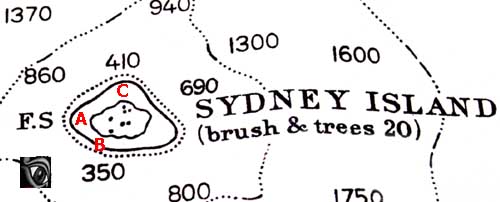
| Date: Nov 22nd |
TI: 0807 |
TO: 0850 |
MaxDepth: 24m |
| Divers: Michel,
Orla, Rich, Keely, Starrlight |
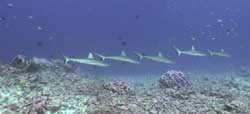
As we approached the shores of Sydney Island, our small boat became
enveloped in a sea of grey reef sharks. Although most of the sharks were
juveniles, there were a few large adults scattered amongst them.
Apprehensive of how the sharks may react to divers, our dive leader
Michel cautiously entered the water to test their reactions. The sharks
were curious but kept their distance, and soon all five of the divers
were submerging themselves into the warm 86°
F waters.
Upon descending, we were overwhelmed by the array and size of the
fish life - the largest parrot fish and red snappers most of the divers
had ever seen, but at the same time quickly disheartened by the state of
the reef. Our expectations were high, we had traveled to what have been
described as some of the most "pristine" reefs in the world.
But all we found were the remnants of a once healthy reef, the majority
of the corals now dead and covered in macroalgae with only a few patches
of live coral. Despite the dying reef, white tip, black tip and grey
reef sharks were prominent throughout the dive. In fact, all of the main
reef predators were present, paradoxically indicating a healthy reef.
| Date: Nov 22nd |
TI: 0930 |
TO: 1012 |
MaxDepth: 20m |
| Divers: Michel,
Carol, Heather, Marco |
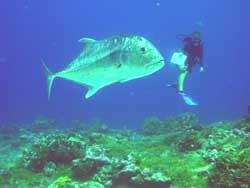
Again the small boat was greeted by an array of sharks. Some of the
adolescent grey reef sharks followed the divers throughout the entire
dive, sometimes less than a foot away.
The predominant fish species was red snapper which averaged over a
foot and a half long. A 3 foot turtle swam past us midway through
the dive. The bottom composition was sand with areas of coral. In the
shallower depths large coral boulders were present.
| Date: Nov 22nd |
TI: 1238 |
TO: 1318 |
MaxDepth: 17m |
| Divers: Michel,
Carol, Orla, Zak |
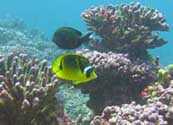
Unlike the previous two dives, this site was comparatively void of
life. There were two sharks, one turtle, as well as blue and black
trevally, some barracuda, and trigger fish. The turbidity was high and a
strong surge was present.
There were larger areas of dead coral here than on the south side of
the island, and a large amount of calcareous algae plus a dense coverage
of red coralline algae that we had also observed at the other two dive
sites.
DIVE LOG
Enderbury Dive Log
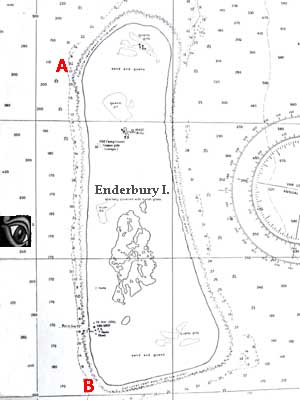
| Date: Nov 25th |
TI: 0930 |
TO: 1016 |
MaxDepth: 23m |
| Divers:
Michel,
Orla, Heather, Marco
|
| Date: Nov 25th |
TI: 1053 |
TO: 1135 |
MaxDepth: 22m |
| Divers:
Carol,
Starrlight, Lindsey, Rich, Kitty
|
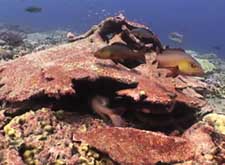
Enderbury is a bird haven - we were surrounded by frigate birds before and after diving, some approaching very closely.
The coral cover at Enderbury was much like Sydney Island. We saw a dying reef, already over 80% dead.
There were more red snappers here than at Sydney, probably because
there were much fewer sharks. There were also large areas
where the corals were overgrown by macroalgae.
| Date: Nov 25th |
TI: 1410 |
TO: 1446 |
MaxDepth: 20m |
| Divers:
Michel, Carol, Keely, Hanna, Zak
|

The divers dropped down at the southwest tip of the Island
and headed north. The bottom composition at the
beginning of the dive was sand and coral rubble with large coral
boulders farther north. A few white tip and grey
reef sharks followed the divers upon ascent
to the small boat.
Canton Dive Log
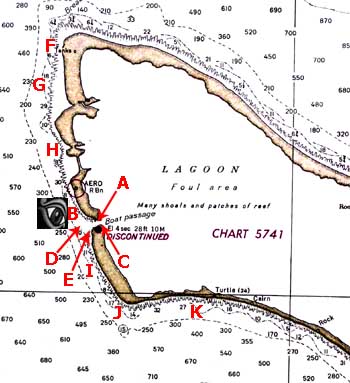
| Date: Nov 26th |
TI: 1540 |
TO: 1550 |
MaxDepth: 10m |
| Divers:
Michel,
Rich
|
Our first glimpse, emphasis on glimpse, of the underwater life in Canton took place in the boat passage. The current racing through the pass often
rages at up to 10 knots - we had chosen to dive the pass with an
ingoing tide.
After descending just outside the dropoff, Michel and Rich quickly found themselves being whisked into the lagoon,
riding the current at full speed ahead!
| Date: Nov 26th |
TI: 1618 |
TO: 1653 |
MaxDepth: 20m |
| Divers:
Lindsey,
Keely, Marco, Zak
|
| Date: Nov 30th |
TI: 1504 |
TO: 1546 |
MaxDepth: 19m |
| Divers:
Lindsey,
Keely, Rich, Marco, Zak
|
| Date: Dec 2nd |
TI: 1030 |
TO: 1110 |
MaxDepth: 21m |
| Divers:
Michel,
Nada
|
| Date: Dec 3rd |
TI: 1958 |
TO: 2041 |
MaxDepth: 23m |
| Divers:
Michel,
Orla, Heather, Keely, Rich, Hanna
|
| Date: Dec 5th |
TI: 1004 |
TO: 1049 |
MaxDepth: 22m |
| Divers:
Lindsey,
Hanna, Rich, Zak
|
| Date: Dec 5th |
TI: 1940 |
TO: 2011 |
MaxDepth: 21m |
| Divers:
Michel,
Carol, Lindsey, Marco, Kitty, Zak
|
| Date: Dec 7th |
TI: 0635 |
TO: 0718 |
MaxDepth: 24m |
| Divers:
Carol,
Heather, Lindsey
|
| Date: Dec 7th |
TI: 0910 |
TO: 0936 |
MaxDepth: 42m |
| Divers:
Michel,
Rich, Marco, Kitty, Nada, Zak
|
| Date: Dec 8th |
TI: 1425 |
TO: 1507 |
MaxDepth: 20m |
| Divers:
Michel,
Rich, Marco, Nada, Kitty, Zak
|
| Date: Dec 8th |
TI: 1538 |
TO: 1627 |
MaxDepth: 35m |
| Divers:
Carol,
Keely, Starrlight
|

The coral surrounding our anchorage was showing
greater signs of struggle than we had seen at Sydney or Enderbury Islands
but paradoxically, the fish life was prolific. Jumping off the
bow of Heraclitus, rainbow runners, trevally and surgeon fish often greeted
us, as the shade of our hull soon became their home.
The ship's anchorage presented an ideal place for night dives, and we took
full advantage.
We could hear the local pod of bottlenose dolphins chattering,
sometimes not so far away. The solemn night-timereef was home to many sleeping parrot fish and red
snappers. We also saw lion fish, shrimp and moray eels which we
rarely saw during the day.
Hundreds upon hundreds of fish larvae were swarming at the surface amongst
the trevally and rainbow runners.
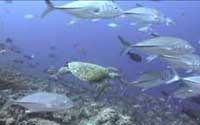
Just after dawn, the reef was vibrant with many turtles and
three manta rays. Traveling south of our anchorage there were rusted ship parts, most likely discarded when the United States occupied Canton as a military base during World
War II.
Among the cast away ruins lay a 10 foot tall anchor with 6
inch-thick chain still attached.
| Date: Nov 29th |
TI: 1520 |
TO: 1545 |
MaxDepth: 09m |
| Divers:
Michel,
Rich
|
| Date: Dec 6th |
TI: 1109 |
TO: 1146 |
MaxDepth: 08m |
| Divers:
Michel,
Carol, Starrlight
|

The main attraction of this dive was the manta rays. At times, as many as eighteen mantas could be seen gliding
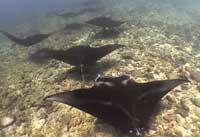 through the water. When the tide was coming in, many nutrients
were flowing into the lagoon, and the mantas would regularly gather
at the mouth of the pass to feed.
Their schedule became so regular that we began taking lunch time snorkel trips to this site
to watch them.
through the water. When the tide was coming in, many nutrients
were flowing into the lagoon, and the mantas would regularly gather
at the mouth of the pass to feed.
Their schedule became so regular that we began taking lunch time snorkel trips to this site
to watch them.
| Date: Dec 1st |
TI: 1540 |
TO: 1605 |
MaxDepth: 24m |
| Divers:
Michel,
Hanna
|
| Date: Dec 1st |
TI: 1615 |
TO: 1639 |
MaxDepth: 30m |
| Divers:
Michel,
Keely
|
| Date: Dec 7th |
TI: 1415 |
TO: 1445 |
MaxDepth: 20m |
| Divers:
Michel,
Rich, Marco, Kitty, Nada, Zak
|
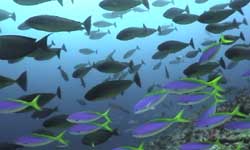
We could only dive here on an ingoing or slack tide.
At the outside of the pass, the ocean floor quickly declines from a depth of 18 meters to 30 meters and then drops off to the
deep blue. Schools and schools of fish crisscross each other, all cramped together,
thriving in the fast flowing current.
Eagle rays, turtles, mantas and sharks all gather here. On one ascent, a school of over 100
great barracuda enveloped us, circling us for over 5 minutes.
| Date: Nov 29th |
TI: 1448 |
TO: 1513 |
MaxDepth: 10m |
| Divers:
Michel,
Rich, Nada
|
| Date: Dec 3rd |
TI: 1247 |
TO: 1328 |
MaxDepth: 18m |
| Divers:
Michel,
Keely, Lindsey, Heather, Marco
|
| Date: Dec 6th |
TI: 1015 |
TO: 1110 |
MaxDepth: 13m |
| Divers:
Michel,
Marco, Zak, Nada, Kitty
|

An old ship wreck from World War II lay strewn off of the southern boat passage into the lagoon. The max depth of the wreck is around nine meters.
Although the current can be quite strong through the interworkings of the vessel, the dive is relatively easy.
 Most of the wreck is open to the overhead waters flooding the nooks and
crannies with sunlight. Many moray eels reside within the holes and plenty
of fish congregate here.
Most of the wreck is open to the overhead waters flooding the nooks and
crannies with sunlight. Many moray eels reside within the holes and plenty
of fish congregate here.
| Date: Nov 30th |
TI: 0950 |
TO: 1042 |
MaxDepth: 16m |
| Divers:
Heather,
Orla, Lindsey, Starrlight, Kitty
|
There were large breakers this far north, so we made a
transect just south of the point. We carried out a full reef
study here in Canton -
click here to see results.
| Date: Nov 29th |
TI: 0854 |
TO: 0940 |
MaxDepth: 12m |
| Divers:
Heather,
Orla, Hanna, Keely
|

We descended just off the shore of an old WWII industrial site to make a
transect dive. We found a richer fish life and slightly higher
cover of live coral than we were used to near the Heraclitus
anchorage. One white tip shark was particularly curious in our
methodologies as we laid our tape measure and documented the state of
the reef here.
| Date: Nov 29th |
TI: 1017 |
TO: 1101 |
MaxDepth: 09m |
| Divers:
Heather,
Orla, Hanna, Keely
|
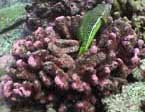
The bottom composition differed from the previous transect sites with large coral boulders and a sandy bottom. The red coralline algae
that we had seen at so many of the dive sites in the Phoenix Islands was
particularly prevalent here. All the Pocillopora colonies
that we observed here were dead, a common trend throughout the fringing reefs at Canton.
| Date: Nov 29th |
TI: 1420 |
TO: 1507 |
MaxDepth: 13m |
| Divers:
Heather,
Orla, Hanna, Lindsey
|
We continued our efforts to make transects at one mile intervals along
the leeward fringing reef of Canton. The fish life here was not as rich as
we had encountered north of the boat passage.
| Date: Dec 2nd |
TI: 1415 |
TO: 1515 |
MaxDepth: 14m |
| Divers:
Heather,
Orla, Hanna, Lindsey
|
| Date: Dec 5th |
TI: 1420 |
TO: 1456 |
MaxDepth: 17m |
| Divers:
Lindsey,
Marco, Nada
|
| Date: Dec 6th |
TI: 1130 |
TO: 1226 |
MaxDepth: 18m |
| Divers:
Heather,
Keely, Hanna
|
| Date: Dec 7th |
TI: 1433 |
TO: 1525 |
MaxDepth: 19m |
| Divers:
Heather,
Lindsey, Hanna, Starrlight
|

This dive site, close to the Heraclitus was a good training
ground for coral identification including
Goniastrea, Montipora, Echinopora, Porites, Pavona and Favia.
| Date: Dec 2nd |
TI: 0910 |
TO: 0952 |
MaxDepth: 14m |
| Divers:
Heather,
Orla, Hanna, Lindsey, Kitty
|
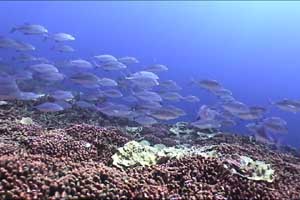
This was our southern most dive site. The waters here were extremely rich with
trevally, napoleon wrasses and plenty other fishes.
In general, the waters of Canton were satiated with fish of
all shapes and sizes, yet depleted of the basic building blocks
of a thriving ecosystem - healthy corals. Will the reefs
recover and the richness of these waters be maintained, or will
the fish population face the
same fate as its life support and
soon dwindle? So many times, we regretted not visiting
these waters while they were "pristine", only two and a half years
ago.
McKean Dive Log
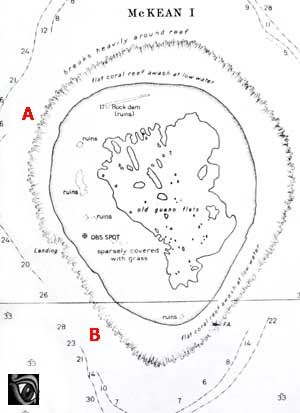
| Date: Dec 14th |
TI: 0958 |
TO: 1053 |
MaxDepth: 22m |
| Divers:
Michel,
Orla, Heather, Keely
|
We were originally contemplating diving the northern side of the
island. However, upon approaching in our small boat the breakers
were too large, and the sea too rough to dive this side of the
island. There was a wrecked fishing ship here, driven
straight onto the reef.

Grey reef sharks swam among us within a foot of our comfort zone.
Some of the highlights of the dive were the golden spotted angelfish,
Apolemichthys guezei, a conference of puffer fish and two turtles.
The reef was in an intermediate state of decay although there was some new growth. The Pocillopora colonies
were healthier than those we had seen at Canton.
| Date: Dec 14th |
TI: 1124 |
TO: 1209 |
MaxDepth: 26m |
| Divers:
Carol,
Lindsey, Starrlight, Marco
|
| Date: Dec 14th |
TI: 1347 |
TO: 1442 |
MaxDepth: 17m |
| Divers:
Michel,
Rich, Hanna, Nada, Zak
|
There were large sand patches here, with reef rays on the bottom. There were many
moray eels, some puffer fish , a manta ray and many barracuda and napoleon
wrasse. Also white tip,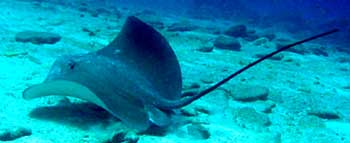 black tip and grey reef sharks.
black tip and grey reef sharks.
The coral life included Pocillopora, Psammacora, Goniastrea, Lobophylia, Montipora, Porites, Leptoseris and a couple of different species of soft coral.
Gardner Dive Log
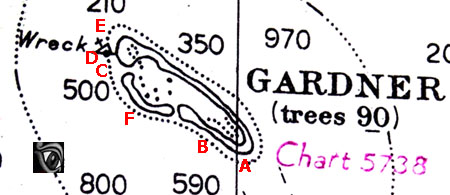
| Date: Dec 16th |
TI: 0915 |
TO: 1016 |
MaxDepth: 23m |
| Divers:
Michel,
Heather, Rich, Nada
|
| Date: Dec 16th |
TI: 1106 |
TO: 1201 |
MaxDepth: 25m |
| Divers:
Carol,
Starrlight, Keely, Marco, Zak
|

Our first glimpse of the reefs at Gardner showed promising
signs. There was a higher percentage of live coral here as well as
some new growth. Interestingly enough the fish life did not appear
as rich on our first two dives at the southern tip.
We could see dolphins could be seen
 off in the distance and they became a regular sighting on our way
to and from the reef here, a resident pod of bottlenose dolphins. On the second dive there was one very curious grey reef shark that followed the divers.
off in the distance and they became a regular sighting on our way
to and from the reef here, a resident pod of bottlenose dolphins. On the second dive there was one very curious grey reef shark that followed the divers.
| Date: Dec 16th |
TI: 1315 |
TO: 1407 |
MaxDepth: 23m |
| Divers:
Michel,
Eddie, Lindsey, Hanna
|
 The
shallows of the fringing reef at Gardner were a black tip reef shark
nursery, as were the waters inside the lagoon. But the sharks were
never the only attraction underwater. The corals here were in much
better shape in general than we had seen at any of the other Phoenix
Islands - perhaps being more to the west, they were less affected by the
2002/3 hotspot in the central Pacific. The
shallows of the fringing reef at Gardner were a black tip reef shark
nursery, as were the waters inside the lagoon. But the sharks were
never the only attraction underwater. The corals here were in much
better shape in general than we had seen at any of the other Phoenix
Islands - perhaps being more to the west, they were less affected by the
2002/3 hotspot in the central Pacific.
| Date: Dec 16th |
TI: 1440 |
TO: 1534 |
MaxDepth: 19m |
| Divers:
Michel,
Eddie, Lindsey, Carol, Keely
|

Many black tip and grey reef sharks were swimming around
and between the divers aggressively here - we also saw two turtles.
One small
green turtle swam very close to us, brushing against one of us
with his fin. The percentage of live coral was lower here than
at the two previous sites, but this dive site was also more
exposed to the breakers.
| Date: Dec 17th |
TI: 1020 |
TO: 1105 |
MaxDepth: 28m |
| Divers:
Carol,
Heather, Hanna, Marco, Eddie
|
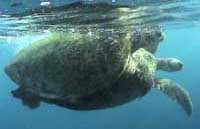
Upon entering the water, the divers encountered two turtles mating. Every
dive at Gardner was full of life and suprises. Our favourite pastime
was to find a place to just hang out and watch the underwater theatre
performance - at times, divers disappeared behind curtains of fish, sharks,
turtles, rays. It seemed like everything was here, and in huge doses.
| Date: Dec 17th |
TI: 1130 |
TO: 1208 |
MaxDepth: 25m |
| Divers:
Michel, Lindsey, Keely, Starrlight, Rich
|
It was close to this dive site that we had one of our most spectacular moments
of this expedition to the Phoenix Islands - a pod of false killer
whales that had been hanging out close to the zodiac attacked and killed an enormous marlin that had been circling Michel,
a little too close for his comfort. They released a high pitched sound in unison just before the attack, the air filled
with the scent of fresh blood and the false killer whales devoured the fish.
| Date: Dec 17th |
TI: 1400 |
TO: 1448 |
MaxDepth: 20m |
| Divers:
Michel, Carol, Nada, Zak
|
| Date: Dec 19th |
TI: 0835 |
TO: 0921 |
MaxDepth: 19m |
| Divers:
Michel,
Orla, Keely, Kitty, Hanna
|
| Date: Dec 19th |
TI: 1015 |
TO: 1055 |
MaxDepth: 21m |
| Divers:
Carol,
Heather, Rich, Starrlight, Zak
|
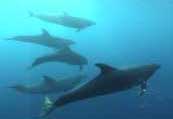
Our last dives here at Gardner were quite spectacular - manta
rays met us at the surface and were unalarmed by our bubbles,
staying for more than ten minutes above us while we sat quietly on
the reef below. We heard the bottlenose dolphins many times.
The Phoenix Islands expedition has been the most extraordinary
journey - a journey through reefs devastated by global warming but
waters crammed with life from fish to turtles to cetaceans. We
can easily say that these probably were some of the most exciting
reefs on the planet only two and a half years ago. It is
impossible to know what they will look like in the future.
|
|



